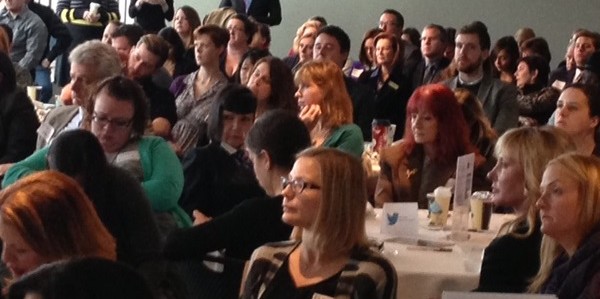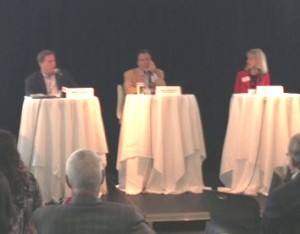
By Elizabeth McGuire
A sold-out crowd joined us for the second of our multi-part series about Austin’s growing divide. This month our panel discussed affordability and housing housing and the challenges and expectations surrounding this important issue. Panelists included Sherri Gallo, Austin City Council Member, District 10; Terry Mitchell, President, Momark Development; and Ward Tisdale, President, Real Estate Council of Austin. KXAN news anchor Shannon Wolfson moderated the discussion, and David Scott, also of KXAN, fielded questions from the audience.
Highlights from the morning:
How did we get here? What has led us to become the most expensive city in Texas?
 According to Gallo, Austin cycles typically about every 10 years with the economy and our housing expenses correct themselves. But this last cycle we’ve had more rapid appreciation than in the last 35 years and the cycle seems to be continuing. The main problem is that our demand is substantial and our supply is minimal at this point.
According to Gallo, Austin cycles typically about every 10 years with the economy and our housing expenses correct themselves. But this last cycle we’ve had more rapid appreciation than in the last 35 years and the cycle seems to be continuing. The main problem is that our demand is substantial and our supply is minimal at this point.
Mitchell agreed, adding that while Austin has had one of the strongest economies in the nation for the past five years, the city has never hit a downturn in terms of population. “We were zero job growth in 2009, which is the lowest we’ve had in the last 20 years, and we grew 55,000 people. They’ve got to live somewhere.”
Tisdale added that Austin is the economic engine of this country and we are all benefitting from that. It provides opportunity, but at a cost. We now have more people moving here with more money than ever before, so that’s certainly going to impact prices.
Tisdale explained that the supply hasn’t kept pace, and quoted a recent report by the Real Estate Council of Austin. “The essence of our white paper is that we need more supply in the city limits. All the growth is in the suburbs. (Suburbs are great and they provide a valuable function) but we need more growth in the city center. And not just more supply, but different kinds of things. The so-called “missing middle.”
Can we afford to keep growing? How do we grow responsibly?
Tisdale said one of the problems we’ve had in Austin is a growth vs. no-growth fight. The focus is on the fight, yet we’re still growing and we’re not planning or investing in infrastructure. “It’s not a question of should we grow or not, but how we grow. Luckily, we have this amazing plan called Imagine Austin. This is how we are going to become a sustainable, wonderful city of the future by becoming more compact and more connected with a greater focus on the environment. The blueprint is right here in front of us, we just need to execute on it.”
Mitchell emphasized links between transportation and housing. As the suburbs grow, the majority of the jobs stay in the urban core. Austin talks about creating a variety of downtowns, or density nodes, so that not everybody has to drive to the core of our city. “It’s the single greatest tool we have to help our transportation,” Mitchell said.
He also believes that how a city grows greatly affects its financial obligations. Inspired by StrongTowns.org, Mitchell compared rapid growth dilemmas using a metaphor of a middle class person winning the lottery. Just because he can afford to buy a mansion with his winnings, doesn’t mean that his annual salary will cover the cost of caring for that mansion longterm.
Gallo agreed with Mitchell regarding the need for non-downtown business centers. She also emphasized the importance of having more consensus among neighborhoods, “where we all buy in to the idea that we’ve got to build those affordable housing units.”
 How will our new city council solve housing problems?
How will our new city council solve housing problems?
Gallo contends that even though the council was elected by different districts, they all represent the interests of the entire city. She said the lack of attention to core services is an issue across the board, and that affordability is a problem in every district.
“I think there will be a lot of consensus on providing core services that have been underserved in most areas of Austin,” she said, “and really addressing the affordable housing in all of the areas of Austin.”
Tisdale explained that the demographics of Austin are changing and the demand for smaller housing is only going to increase as the millennial generation ages. He supports legalizing back houses (a.k.a. granny flats or garage apartments) throughout the city. “There are parts of town where it’s legal and parts of town where it isn’t, which fundamentally makes no sense. That’s the kind of low-hanging fruit, or “invisible density” as Chris Riley called it, that we need to get going here in Austin.”
How do we make sure Austin is not becoming a more divided city?
Gallo acknowledged that with rapid appreciation in an area or neighborhood, the number one question should be “How does it displace the people who have been there forever?” She said, “When we are forcing people to leave because it’s unaffordable for them to stay then that’s something we really need to listen to and come up with a solution.”
As she elaborated, everything starts with the land price, which differs substantially across areas of Austin. And then you build what the market will bear. While she believes it’s appropriate to put affordable housing in certain neighborhoods if it serves a demand, “if it’s forced just because you want to have that geographic representation, I think you have to be careful about that.”
What can our City Council specifically do to make housing more affordable in Austin?
Tisdale believes that the first thing is to adhere to the Imagine Austin plan. “The code rewrite is in effect…let’s make sure that code matches the plans.” He believes the council should enact creative policies to help supply and find or create “missing middle” type products. He supports appropriate density in appropriate locations.
Gallo said it currently takes too long to get projects through city departments and that the government should speed up the process evaluation inefficiencies. She also believes that as the city makes policy decisions, every proposed regulation or ordinance needs to have an evaluation of the cost effect on taxpayers.
Sherri Gallo: When we talk about affordable housing, often people think of low income and crime. Many people who benefit from affordable housing are young, entry-level workers and fixed-income senior citizens. I encourage people to convey the positiveness of providing affordable housing.
Terry Mitchell: The greatest thing you can do is exactly what you’re doing by being here and educating yourself. Talk to your City Council member. Most of the time, in my experience, when we’ve had big issues like this, we all have the same goal…but we approach it differently. We all have to be operating from the same base of knowledge before we can begin to make decisions together.
Ward Tisdale: Get involved. Contact your City Council member…they will listen. Join an advocacy group–there are a number of organizations that are really concerned about these issues and can have an impact. Lastly, we have the plan (Imagine Austin); it just needs to be executed. We are a suburban city for the most part, and we’re trying to become an urban city…let’s get involved and make it happen.

